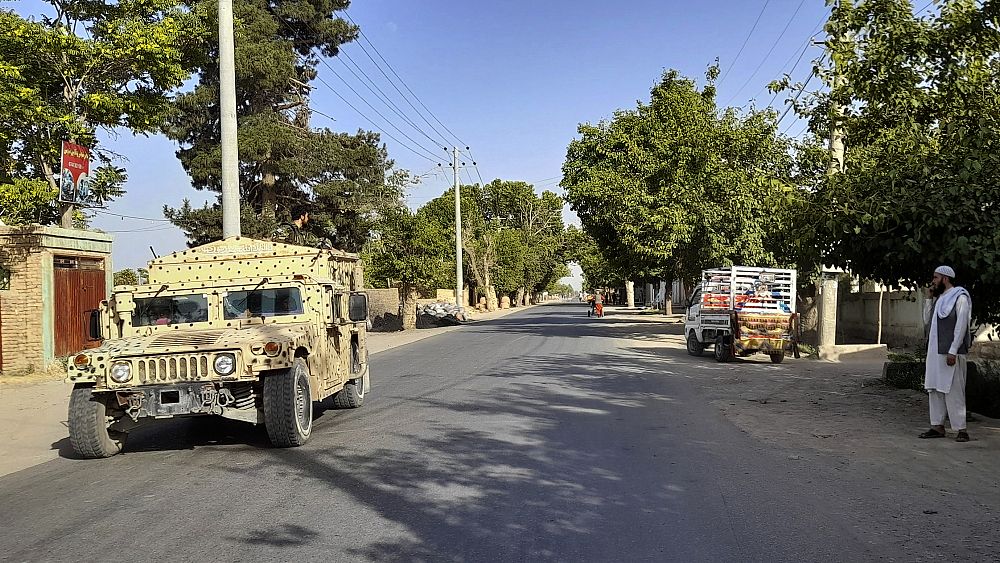Storms and floods in Europe forced a record 126,000 people from their homes last year, a new report has revealed.
The figure represents just over half of the continent”s disaster displacements in 2020.
The Internal Displacement Monitoring Centre (IDMC) said flooding had triggered a record 120,000 displacements, while 5 major storms displaced 6,200 people across nine countries, “double the annual average for the last decade”.
IDMC’s annual report also revealed, globally, there were 40.5 million new displacements triggered by disasters and violence in 2020. That is the highest annual figure recorded in a decade.
And for the second year in a row, disasters and extreme weather displaced three times as many people as war and conflict in 2020 around the world.
Europe hit by storms and flooding in 2020
In Europe, the year 2020 started with storm Gloria and ended with storm Bella.
Gloria led to more than 2,200 people being displaced in southwestern France and eastern Spain in January. As the equivalent of four to five months’ rain fell in 72 hours in France, 14 people died in Spain due to the intense flooding.
In the UK, February 2020 was the warmest and fifth-wettest on record, prompting torrential rains that triggered around 1,100 displacements. And the rains didn’t stop then.
During summer intense flooding continued throughout Europe and Central Asia, while warmer temperatures increased the risk of wildfires, which forced 23,000 people from their homes, in Spain, Greece and France.
Ukraine was impacted by wildfires at the end of September, prompting around 1,000 evacuations and in April, near the Chernobyl exclusion zone, causing around 200 displacements due to the increase in radiation levels.
Globally, conflict and violence accounted for 9.8 million displacements, while weather-related disasters caused 30 million – accounting for 98% of all disaster displacements.
“Intense cyclone seasons in the Americas, South Asia and East Asia and the Pacific, and extended rainy seasons across the Middle East and sub-Saharan Africa, uprooted millions of people”, says the report.
Geo-physical disasters, such as earthquakes and volcanic eruptions displaced 655,000 in total.
Busting myths around displacement
Euronews interviewed Alexandra Bilak, director of the IDMC, whose report this year deconstructs some misconceptions about climate migrations.
Myth 1: Weather displacement is short term
This misconception is based on a lack of figures on long-term displaced people. “Most of the data that is available to us in a disaster context comes from national governments who count the number of people who are often evacuated in a situation of crisis when a disaster strikes and typically in those cases, the data stops being collected a few weeks or maybe months following a disaster, ” says Bilak. “There’s very little monitoring of the situation of people over a longer period of time.”
However, Bilak cites several examples from around the world of how people can end up displaced in the long term with the uncertainty of whether they will ever be able to return to their homes. “300,000 people who are still displaced today in Bangladesh as a result of Cyclone Amphan; we’ve got several dozens of thousands of people still displaced as a result of the Fukushima disaster in Japan; we have people in the US who are still displaced as a result of Hurricane Katrina over 10 years ago, etc.”
“It’s mostly those families who don’t have insurance or who are of the lower socio economic sort of income who will suffer disproportionately from these impacts, and those are typically things that go very underreported, including in Europe,” she adds.
Myth 2: Climate change will lead to mass migration across borders
“There is no evidence that shows that”, says Bilak, “and our report shows that the majority of people who are becoming displaced by these disasters are staying in their home countries.”
“Many of them are not even travelling that far,” she adds.
After a devastating storm or fire, people who are left homeless prefer not to move far away. They usually have deep ties to the region, such as family, work or memories. This makes the recognition of climate displacement status a national challenge that most governments have so far failed to regulate.
Myth 3: Small scale climate events are harmless
Sometimes it is not a mega-fire but a confluence of small fires and an everytime more recurrent drought in a region that leaves a person in their hometown with no future.
“We have a lot of data on the mega events, but very little data and very little information regarding small scale events”, says Bilak.
“But in fact, what we did want to show is that of all the small events that we detected in 2020, they triggered very small numbers of new displacements. What we’re worried about is how they may undermine people’s lives and people’s livelihoods.”
“If you accumulate that over time and if you account for the fact that many people are affected repeatedly by these small scale events from one year to the next, we need to then consider what that means for the resilience and the future stability and development of these communities.”
Looking beyond for a solution
It is in the countries that have been hardest hit by disasters that the most advanced plans to protect displaced people are being developed.
As examples, Bilak cites Bangladesh, Ghana, Peru and Fiji.
“Bangladesh has a very comprehensive policy framework at the national level that covers the issue of internal displacement that’s linked with disasters and climate change.
“We’ve got Ghana, for example, that has included internal displacement in its national climate change policy.
“We’ve looked at Peru that has a law that addresses climate change and that also acknowledges the risk of internal displacement that can result also from environmental causes.
“And Fiji has really embraced this issue as an existential threat to the existence of the country and are proactively thinking through how to relocate communities away from coastlines.”
Relocation with dignity, respecting the original socio-cultural structure of the destroyed community, is one of the main global goals as disasters become the major trigger of displacements.








